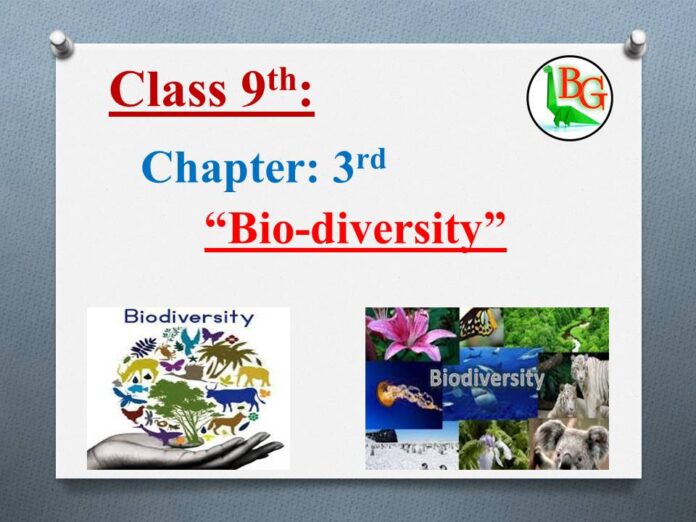
9th class biology MCQs and Important Questions
Chapter No: 3
“Bio-diversity”
1. The diversity of plants called…….
a) Flora
b) Fauna
c) Variety of species
d) Both (a) & (b)
Sol: (a) Flora.
2. The diversity of animals called……..
a. Flora
b. Animal biology
c. Fauna
d. None of the above
Sol: (c) Fauna.
3. The branch of biology that deals with the classification of organisms is called…….
a) Systematics
b) Taxonomy
c) Taxa
d) Taxonomic hierarchy
Sol: (b) Taxonomy.
4. The branch which deals with classification & also traces the evolutionary history of organisms is called……….
a) Taxonomy
b) Systematics
c) Genus
d) Species
Sol: (systematics).
5. The groups into which organisms are classified are called………..
a) Taxa
b) Taxonomic categories
c) Taxon
d) All of the above
Sol: (d) All of the above.
6. The “taxa” from a ladder called…..
a) Taxonomic hierarchy
b) Taxonomic categories
c) Taxon
d) Both (a) and (b)
Sol: (a) Taxonomic hierarchy.
7. All organisms are divided into ………..kingdoms?
a) 3
b) 4
c) 5
d) 2
Sol: (c) 5.
8. The largest “taxon” is………..
a) Genus
b) Family
c) Species
d) Kingdom
Sol: (d) Kingdom.
9. Correct sequence of classification is………..
a) Order, family, genus
b) Phylum, class, order
c) Class, order, family
d) All of the above
Sol: (a) All of the above.
10. Class is a group of related……
a) Order
b) Family
c) Class
d) Genus
Sol: (a) Order
11. Family is a group of related………
a) Order
b) Species
c) Genus
d) Class
Sol: (c) Genus.
12. Genus is a group of related………
a) Species
b) Family
c) None of the above
d) Order
Sol: (a) Species.
13. According to classification, what is “human” order
a) Chordate
b) Primates
c) Homo
d) Magnoliopsida
Sol: (b) Primates.
14. The basic unit of classification is……
a) Species
b) Class
c) Order
d) Phylum
Sol: (a) Species.
15. The animal that is unable to reproduce is…..
a) Monkey
b) Bats
c) Gorillas
d) Mule
Sol: (d) Mule.
16. Who classified living organisms into “Plantae” and “Animalia” …?
a) John Ray
b) Aristotle
c) Carolus Linnaeus
d) Ibn Rushd
Sol: (b) Aristotle.
17. Who describes the characteristics of 350 species of animals in his book…..?
a) Ibn Rushd
b) Aristotle
c) Abu-Usman Umer Aljahiz
d) Augustus Rivinus
Sol: (c) Abu-Usman Umer Aljahiz.
18. Who wrote a lot of books on ants?
a) Tournefort
b) Abu-Usman Umer Aljahiz
c) Ernst Hackel
d) Ibn Rushd
Sol: (b) Abu-Usman Umer Aljahiz.
19. Who translated Aristotle’s book “de Anima” into Arabic
a) Ibn Rushd
b) John Ray
c) Andrea Caesalpino
d) Darwin
Sol: (a) Ibn Rushd.
20. Who divided plants into fifteen groups…..?
a) John Ray
b) Andrea Caesalpino
c) Tournefort
d) Ibn Rushd
Sol: (b) Andrea Caesalpino.
21. Who introduce the taxon of “order”
a) Tournefort
b) Carolus Linnaeus
c) Augustus Rivinus
d) Aristotle
Sol: (c) Augustus Rivinus.
22. Organisms that can prepare their own food from simple inorganic materials are called……
a) Heterotrophs
b) Autotrophs
c) Producers
d) Consumers
Sol: (b) Autotrophs.
23. Who proposed a three- kingdom classification system?
a) Robert Whittaker
b) Ernst Hackel
c) Margulis
d) Schwartz
Sol: (b) Ernst Hackel.
24. When did Ernst Hackel propose a three-kingdom classification system?
a) 1865
b) 1866
c) 1867
d) 1966
Sol: (b) 1866
25. What the term E-Chatton suggested to describe bacteria…………
a) Eucariotique
b) Procariotique
c) Eucalyptus
d) None of the above
Sol: (b) Procariotique.
26. Who introduced the five-kingdom classification system?
a) Margulis
b) Schwartz
c) Margulis and Schwartz
d) Robert Whittaker
Sol: (d) Robert Whittaker.
27. When did Margulis & Schwartz modify the five-classification system?
a) 1988
b) 1888
c) 1987
d) 1887
Sol: (a) 1988.
28. Which kingdom includes prokaryotic organisms?
a) Kingdom Protista
b) Kingdom Animalia
c) Kingdom monera
d) Kingdom Fungi
Sol: (c) Kingdom Monera.
29. “Cyanobacteria” in which kingdom are classified
a) Kingdom Protista
b) Kingdom monera
c) Kingdom Plantae
d) Kingdom Fungi
Sol: (b) Kingdom Monera.
30. Most fungi are………….organisms.
a) Multicellular
b) Unicellular
c) Both (a) and (b)
d) None of the above
Sol: (a) Multicellular.
31. Mushrooms are an example of a kingdom…….
a) Fungi
b) Plantae
c) Animalia
d) Monera
Sol: (a) Fungi
32. Prions are composed of…….
a) Circular DNA
b) RNA
c) Protein only
d) Both (a) and (b)
Sol: (c) Protein only
33. Viroids are composed of ………
a) Circular DNA
b) Circular RNA
c) Protein
d) Lipids
Sol: (b) Circular RNA
34. Binomial nomenclature method was first time introduced by……
a) Charles Darwin
b) Carolus Linnaeus
c) Alexander Fleming
d) Ibn Sina
Sol: (b) Carolus Linnaeus.
35. The method of giving scientific names to living organisms are called………
a) Nomenclature
b) Binomial nomenclature
c) Scientific notation
d) Scientific method
Sol: (b) Binomial nomenclature.
36. “Bauhinia variegate” is a/an …………….tree found in Southeast Asia.
a) Medical
b) Ornamental
c) Gum
d) Iconic
Sol: (b) Ornamental.
37. The common name of “onion” is……..
a) Piyaz
b) Ganda
c) Bassal or vassal
d) All of the above
Sol: (d) All of the above.
38. A vertebrate animal with fins and gills is called………
a) Fish
b) Sparrow
c) Bacteria
d) Virus
Sol: (a) Fish.
39. Scientific name of “onion” is
a) Asterias Rubens
b) Allium cepa
c) Corvus splendens
d) None of the above
Sol: (b) Allium cepa
40. Scientific names are usually printed in…….
a) Arabics
b) Italics
c) Greeks
d) English
Sol: (b) Italics.
41. The ……………..name begins with a capital letter.
a) Species
b) Generic
c) Scientific
d) Common
Sol: (b) Generic
42. “Allium cepa” is the scientific name of…….
a) House crow
b) Onion
c) Starfish
d) Jellyfish
Sol: (b) Onion
43. Scientific name of “House Crow” is………..
a) Allium cepa
b) Rana tigrina
c) Corvus splendens
d) Blattodea
Sol: (c) Corvus splendens
44. A species is at risk of extinction in near future called……….
a) Extinct species
b) Endangered species
c) Threatened species
d) Micro species
Sol: (b) Endangered species.
45. Starfish eats………
a) Mussels
b) Snails
c) Fungi
d) algae
Sol: (a) Mussels.
46. “Eucalyptus plant” was imported from……..
a) Canada
b) Australia
c) Japan
d) China
Sol: (b) Australia
47. The national bird of Pakistan is…..
a) Markhor
b) Chakor
c) Hummingbird
d) Kingfisher
Sol: (b) Chakor
48. WWF-P stands for……..
a) World wildlife forum Pakistan
b) World wildlife fund Pakistan
c) Worldwide fund Pakistan
d) All of the above
Sol: (b) World wildlife fund Pakistan.
49. Number of people increasing in the world population after every one minute is……
a) 180
b) 280
c) More than 180
d) Almost 180
Sol: (c) More than 180
50. When Himalayan Jungle Project (HJP) started in Palas Valley?
a) 1891
b) 1991
c) 1291
d) 1892
Sol: (b) 1991
51. The northern areas provide habitats to the following …..
a) Deer
b) Snow leopard
c) Flying squirrel
d) All of the above
Sol: (d) All of the above
52. According to WWF-P, how many animals of the species of Indus dolphin left in the Indus River?
a) 604
b) 601
c) 600
d) 605
Sol: (c) 600
53. Marco Polo sheep is found in…….
a) Chitral Gol national park
b) Khunjerab National park
c) Ayub national park
d) Keerthar national park
Sol: (b) Khunjerab national park
54. Houbara bustard flies Pakistan in which season?
a) Spring
b) Summer
c) Winter
d) Autumn
Sol: (c) Winter
55. What is the decline of the Houbara Bastard population in Pakistan
a) Hunting
b) Destruction of its habitat
c) Both (a) and (b)
d) None of the above
Sol: (c) Both (a) and (b).
56. The national animal of Pakistan.
a) Ibex
b) Urial
c) Markhor
d) Whales
Sol: (c) Markhor.
57. In binomial nomenclature, the first letter of the ………..name is capitalized.
a) Family
b) Species
c) Class
d) Genus
Sol: (d) Genus
58. Which of the following may be the correct way of writing the scientific name of an organism?
a) Saccharum
b) E. Coli
c) Canis lupis
d) Grant’s gazelle
Sol: (c) Canis lupis
59. Cutting down trees for the conversion of forest to non-forest land.
a) Vulnerable
b) Protista
c) Genus
d) Deforestation
Sol: (d) deforestation
60. When the last member of a particular species dies, the species is said to be……….
a) Established
b) Extinct
c) Threatened
d) Endangered
Sol: (b) Extinct
61. Which sense does the Indus dolphin use to find it’s pray?
a) Hearing
b) Smell
c) Touch
d) Vision
Sol: (a) hearing
Important definitions in 2nd chapter of 9th class Biology:
1. Define biodiversity?
2. Define taxonomy?
3. Define systematics?
4. Define taxonomic hierarchy? (Very Imp.)
5. Define species?
6. Define viruses?
7. Define binomial nomenclature?
8. Define endangered species? (Very Imp.)
9. Define deforestation?
10. Define fauna and flora? (Very Imp.)
11. Define taxon?
Frequently asked questions in previous board and school tests:
Note:
“The highlight questions are more important.”
1. Explain the term biodiversity?
2. Write the importance of biodiversity?
3. Write the aims of classification? (very Important)
4. What is the basis of classification?
5. Write the name of the taxa of classification in a sequence?
6. Write a short note on the history of classification?
7. Explain the five-kingdom classification system?
8. Explain kingdom Protista?
9. Difference between prions and viroids?
10. Write the rules of binomial nomenclature?
11. Write the significance of binomial nomenclature?
12. What are the major causes of species extinction?
13. How removal of species effects biodiversity?
14. How add of species effects biodiversity?
15. Write the causes and effects of deforestation?
16. What is the importance of forests?
17. Write the steps for the conservation of biodiversity?
18. Explain endangered species in Pakistan?
19. Difference between extinct and endangered species?
20. Write the contributions of Ernst Hackel to the classification system?
21. Write down a simple classification of humans?
22. How many types of protists explain it?
23. Write the characteristics of kingdom fungi?
24. Write the reasons for the loss of biodiversity?
25. Write a short note on Houbara Bastard?
26. What is meant by soil erosion?
27. Difference between autotrophs and heterotrophs?
(Work in silence, let success makes a noise)
If you want to learn about 9th class biology chapter 2nd “Solving a biological problem”
Connected with http://beingghazali.com



Good effort ☺️☺️☺️☺️
🙂🙂🙂👍👍👍👍
excellent effort
Thanks for your precious compliment.
That’s real brilliant practice for me
Thanks for your feedback. Thanks for your precious time and effort.
It’s a superb job
Well done
God bless you
👍👍
Thanks for your time and kind words sir. Allah bless you too. Amwwn
Good work
Thanks for your appreciation